|
|
| home | features | exhibitions | interviews | profiles | webprojects | gazetteer | links | archive | forum |
|
Wild
Things: New Beginnings When a single work of art heavily influences sculptural practice for virtually a century, it is not surprising that it stands out in an exhibition of a hundred or so pieces. It is surprising, however, to discover that the work was largely destroyed as soon as it was made. Jacob Epstein’s Rock Drill, which was only reconstructed with the help of an enthusiastic Cornish mining company, is one of a number of reasons to visit the Royal Academy’s exhibition.
Like their literary counterparts, T.S Eliot and Ezra Pound who were constructing a new poetic, Epstein, Gaudier-Brzeska and Gill were drawn to London as the physical vortex for the era’s avant-garde ideas and the creation of a new sculpture. From their diverse backgrounds and starting points the sculptors crossed each other’s paths and, in different ways complemented and reinforced each other’s work. Epstein was from New York, an orthodox Jew of Polish extraction; Gaudier-Brzeska was the son of a French Carpenter; and Eric Gill was from Brighton, a Catholic-in-waiting and the son of a Calvinist Minister and South Seas missionary. The strength of this exhibition, of reacquainting the trio with each other (and the public with them), is that it displays the individuality of their work as well as their collective rejection of the old and their shaping of the new. Intentionally or otherwise, Wild Thing serves as a reintroduction to Epstein, a recognition of Gaudier-Brzeska, and a rehabilitation of Gill.
The Madonna and Child series, Naked Mother and Child and Garden Statue – The Virgin (below right) are exquisite examples of devotional sensuality. Gill’s more secular sculpture such as Boxers (1913), is dynamic and enthusiastically primitive, and shows Gill as a precursor of more recognisably modernist forms of representation.
Like Gill (and Epstein), Gaudier-Brzeska carved direct from stone rather than relying on moulds and casts, an appropriately primitive method. Unlike Gill however, Gaudier-Brzeska showed astonishing originality in his experimentation with semi-abstract forms in works such as Redstone Dancer and Bird Swallowing a Fish (below X2). As with other artists of the Vorticist movement, Gaudier-Brzeska felt that pure and semi-abstract forms were the only ones capable of representing, and giving sense to the machine age.
If Gill is well represented in Wild Thing, the
Gaudier-Brzeska works are unrepresentatively weak, certainly compared with the
Pompidou centre exhibition, and indeed some of the works at Kettle’s Yard in
Cambridge. With some notable exceptions (Bird Swallowing a Fish, and Birds
Erect), the more radically abstract impulses of Gaudier-Brzeska’s work are
missing from this exhibition. This is a shame. On balance, his oeuvre is
significantly more radical and challenging than Gill’s, at least in terms of
experiments in form.
Jacob Epstein’s contribution to Wild Thing is perhaps the most satisfactory. Having tired of the more classical training ground of Paris, Epstein moved to London where he was inspired by his friend Gill to experiment with direct carving. Although Epstein’s early work bore resemblance to Gill’s, his later visits to Paris brought him in close contact with Brancusi and Modigliani. The influence of more abstract forms then becomes evident in Epstein’s English output. The exhibit Doves (1913-15) (below left) shows three versions of a pair of doves in various stages of mating. The first version is relatively naturalistic, less so the second. By the third version, the representation is more strongly abstract. Taken together the series seems to chart the general development in Epstein’s use of form.
Epstein’s Rock Drill is perhaps the greatest expression of man in the machine age, and of the potential horrors that mechanisation could create. Wild Thing is particularly strong in showing the development of Epstein’s masterpiece through the numerous preparatory sketches drawn from private collections and galleries (below). A consistent feature of these drawings is the perspective. The viewer, the individual citizen, is always forced to look up, subjugated before he has even taken in the image. The machine bears down upon us all. On looking up, we see an armour-plated torso, part human, part animal and part machine. It sits astride a massive rock drill mounted on a huge, phallic tripod. (It was the first time in England that a work of art had incorporated a ready-made object.) Mounted on top of his symbolic machine-gun, the driller clasps the trigger with a single hand. It is a depiction of man and machine in which they have become one, but where the machine is dominant. The driller’s gender has also been conflated: powerfully male yet carrying what appears to be its own offspring in its stomach, a mechanical, hermaphrodite everyman. It is sinister, powerful and frightening.
Despite its only having been exhibited once, Rock Drill had been viewed in private by a number of sculptors and had entered public consciousness through photographs published in newspapers. It was only in 1974, when Richard Cork curated a Vorticist retrospective at the Hayward Gallery that the idea of reconstructing Rock Drill came about. The project originally looked like failing as no rock drill could be found to match the original. Fortunately, Holman Brothers, the world-renowned Cornish mining company, stepped in and volunteered its museum piece. Perhaps we need to be reminded what Frankenstein looks like so that we won’t bring him to life again. |
|
Matt Cox 19/1/10
|

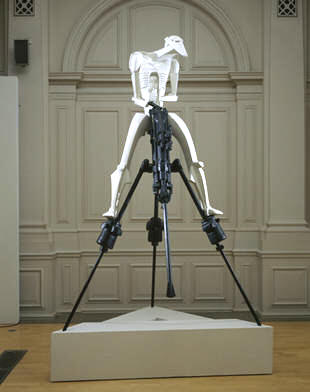 Wild
Thing at the Royal Academy is an exhibition that brings together the work of
three very different sculptors from very different backgrounds, each of them
finding expression for their artistic non-conformism at the end of the belle
époque. This exhibition focuses on the period 1906 to 1916, the period that
bridged two remarkably different eras and established pure form as the new
beginning of English sculpture. During this time, Jacob Epstein, Henri Gaudier-Brzeska
and Eric Gill carved out a radical new future for the plastic arts. They moved
away from the sterile representational forms and classical ideals of the
Victorians and Edwardians, and towards a new dynamism which expressed the world
order of the machine age and the horrors of world war.
Wild
Thing at the Royal Academy is an exhibition that brings together the work of
three very different sculptors from very different backgrounds, each of them
finding expression for their artistic non-conformism at the end of the belle
époque. This exhibition focuses on the period 1906 to 1916, the period that
bridged two remarkably different eras and established pure form as the new
beginning of English sculpture. During this time, Jacob Epstein, Henri Gaudier-Brzeska
and Eric Gill carved out a radical new future for the plastic arts. They moved
away from the sterile representational forms and classical ideals of the
Victorians and Edwardians, and towards a new dynamism which expressed the world
order of the machine age and the horrors of world war. 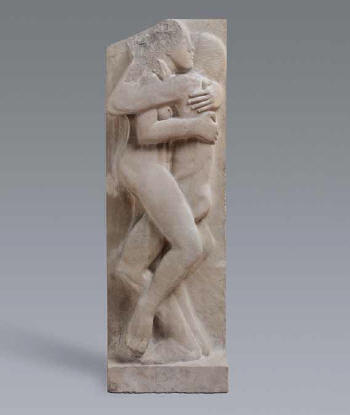
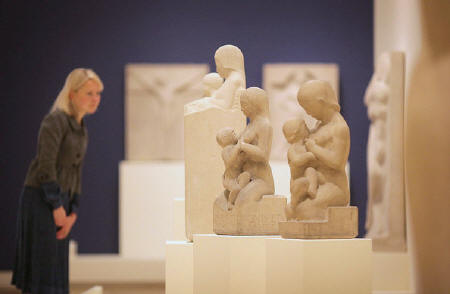
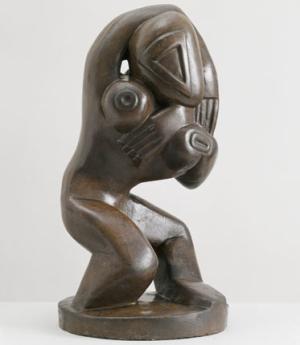 Gaudier-Brzeska
is the ‘wild thing’ of the exhibition’s title. When Ezra Pound first met the
young Frenchman he characterised him as ‘a well made young wolf or some soft-
moving, bright-eyed wild thing.’ The lack of recognition in this country for
Gaudier-Brzeska’s work is puzzling. If this is because he is too ‘foreign’,
either in nationality or taste, that would be unfair. England has a record of
accommodating and acclimatizing to the unfamiliar. If Gaudier-Brzeska is finally
recognized as a result of this exhibition, that will be sufficient measure of
its success. Until as recently as last year, and the Pompidou Centre’s
exhibition dedicated to him, Gaudier-Brzeska has been similarly under-recognized
in his native France. (Perhaps the general release of Savage Messiah, Ken
Russell’s 1972 film of Gaudier-Brzeska’s life, would see his popularity rise.
Featuring a young, naked Helen Mirren, it would be a deviously populist way of
advertising his talents, as well as her’s.)
Gaudier-Brzeska
is the ‘wild thing’ of the exhibition’s title. When Ezra Pound first met the
young Frenchman he characterised him as ‘a well made young wolf or some soft-
moving, bright-eyed wild thing.’ The lack of recognition in this country for
Gaudier-Brzeska’s work is puzzling. If this is because he is too ‘foreign’,
either in nationality or taste, that would be unfair. England has a record of
accommodating and acclimatizing to the unfamiliar. If Gaudier-Brzeska is finally
recognized as a result of this exhibition, that will be sufficient measure of
its success. Until as recently as last year, and the Pompidou Centre’s
exhibition dedicated to him, Gaudier-Brzeska has been similarly under-recognized
in his native France. (Perhaps the general release of Savage Messiah, Ken
Russell’s 1972 film of Gaudier-Brzeska’s life, would see his popularity rise.
Featuring a young, naked Helen Mirren, it would be a deviously populist way of
advertising his talents, as well as her’s.)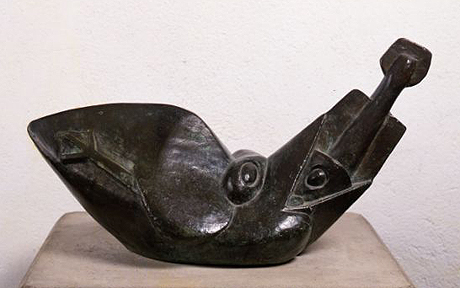 However,
the Gaudier-Brzeska work exhibited here emphasises the harmony with Gill’s work
rather than its more telling dissonance. Beautiful though they undoubtedly are,
sculptures like Singer and Mermaid owe more to the tradition that Gaudier-Brzeska
was leaving behind than the new sculptural landscape he was beginning to map
out; so that the wild is left out of most of his things. The
under-representation of his radical forms means that the exhibition fails
adequately to convey the irony of his early death. Struggling to find forms
which gave meaning to the machine age, Gaudier-Brzeska was killed in action in
1915 in the first mechanised war, in which tanks and lightweight machine guns
maximised the efficiency of killing.
However,
the Gaudier-Brzeska work exhibited here emphasises the harmony with Gill’s work
rather than its more telling dissonance. Beautiful though they undoubtedly are,
sculptures like Singer and Mermaid owe more to the tradition that Gaudier-Brzeska
was leaving behind than the new sculptural landscape he was beginning to map
out; so that the wild is left out of most of his things. The
under-representation of his radical forms means that the exhibition fails
adequately to convey the irony of his early death. Struggling to find forms
which gave meaning to the machine age, Gaudier-Brzeska was killed in action in
1915 in the first mechanised war, in which tanks and lightweight machine guns
maximised the efficiency of killing.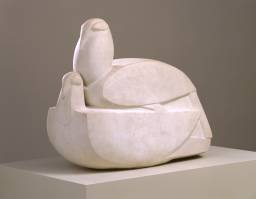 From
the theoretical perspective, the philosopher T.E. Hulme saw the move toward
abstraction in English art as part of a general shift away from classical
naturalism and towards a more geometric form of representation which would
ultimately find fulfilment in the idea of machinery. In art, this mechanism was
already finding expression in the Vorticist paintings of Wyndham-Lewis. In
sculpture, it is evidenced in works such as C.R.W. Nevinson’s Automobilist or
Machine Slave, with its emphasis on the angular and the mechanical. The head of
the automobilist, or driver, is constructed from forms that bear resemblance to
car engine parts, man merging with his machine.
From
the theoretical perspective, the philosopher T.E. Hulme saw the move toward
abstraction in English art as part of a general shift away from classical
naturalism and towards a more geometric form of representation which would
ultimately find fulfilment in the idea of machinery. In art, this mechanism was
already finding expression in the Vorticist paintings of Wyndham-Lewis. In
sculpture, it is evidenced in works such as C.R.W. Nevinson’s Automobilist or
Machine Slave, with its emphasis on the angular and the mechanical. The head of
the automobilist, or driver, is constructed from forms that bear resemblance to
car engine parts, man merging with his machine.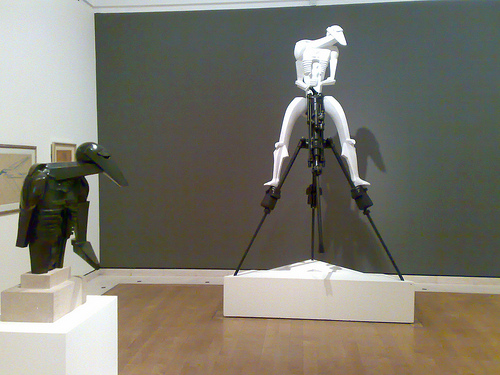 Despite
its obvious connotations of mechanised violence and of war, Rock Drill was
conceived before the outbreak of World War I, and can be seen as depicting the
symptoms of war rather than responding directly to its effects. Having only
exhibited Rock Drill once, Epstein dismantled it, sold the drill and made a cast
of the torso. Epstein himself referred to the work as ‘the terrible
Frankenstein’s monster we have made ourselves into.’
Despite
its obvious connotations of mechanised violence and of war, Rock Drill was
conceived before the outbreak of World War I, and can be seen as depicting the
symptoms of war rather than responding directly to its effects. Having only
exhibited Rock Drill once, Epstein dismantled it, sold the drill and made a cast
of the torso. Epstein himself referred to the work as ‘the terrible
Frankenstein’s monster we have made ourselves into.’